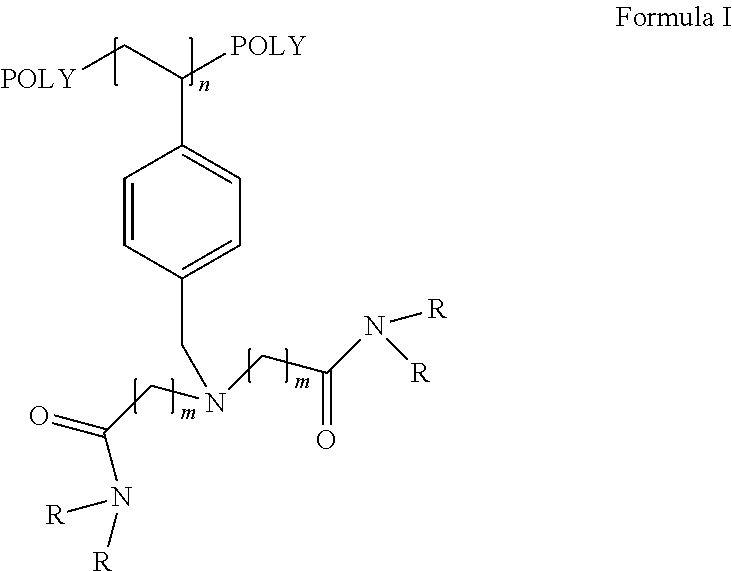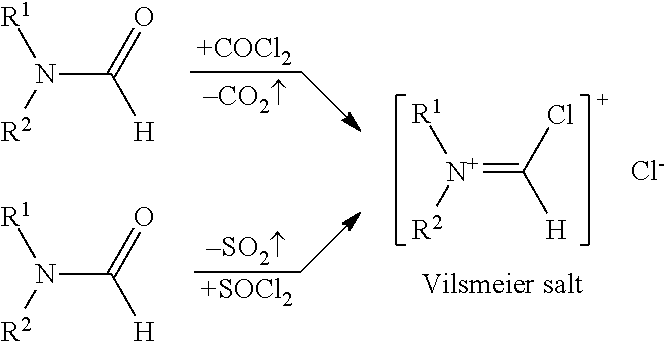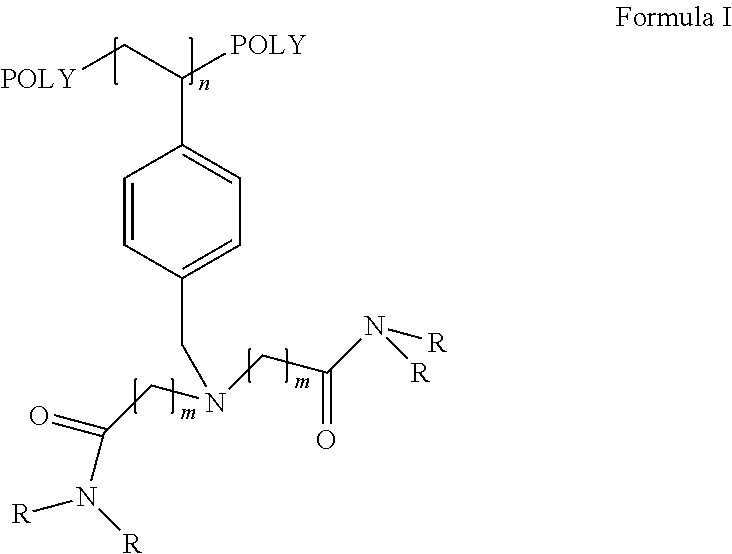Recyclable catalysts for chlorination of organic acids and alcohols
a technology of organic acids and catalysts, applied in the field of polymer based catalysts for chlorination, can solve the problems of easy separation of heterogeneous catalysts from products, and achieve the effects of avoiding purification steps, avoiding loss of efficiency, and facilitating product separation
- Summary
- Abstract
- Description
- Claims
- Application Information
AI Technical Summary
Benefits of technology
Problems solved by technology
Method used
Image
Examples
example 1
Functionalization of Merrifield Resin: Reaction of diethyl iminodiacetate with the Resin: N, N-di (ethyl acetate), aminomethyl polystyrene
[0058]A mixture of chloromethyl polystyrene (2 g, equivalent to 8 mmol of chloromethyl group), dioxane (10 mL) and diethyl iminodiacetate (2.0 g, 10.5 mmol) was stirred under nitrogen at 80-85° C. for 24 hours.
[0059]The chloromethyl styrene (Merrifield resin) was filtered and washed with diethyl ether (20 mL). The washed resin was further stirred with ether (20 mL) for 30 minutes and the resin was separated by centrifugation from solvent. This operation of stirring with ether and then centrifugation to separate it from solvent was repeated two times. It was further washed with dichloromethane (20 mL×2). Drying on a rotary evaporator under vacuum yielded (2.6 g) granular resin with diethyl acetate moiety.
[0060]IR (cm-1): 1739
example 2
Synthesis of N, N-di (N, N-diethyl acetamido) aminomethyl polystyrene
[0061]Heterogeneous mixture of N, N-di (ethyl acetate), aminomethyl polystyrene resin of Example 1 (2.2 g), dioxane (10 mL) and diethyl amine (10 mL) was stirred at 145-150° C. for 24 hours. The reaction was carried in a pressure vessel at a pressure of 8 kgf / cm2 at 150° C. The resin beads were then separated by filtration and washed with diethyl ether (20 ml×3) and dichloromethane (20 ml×3) several times. Drying under vacuum yielded 2.6 g of N, N-diethyl amido functionalized resin as pale yellow beads.
[0062]IR (cm−1): 1648, 1659
example 3
Synthesis of β-Alanine, N-(3-ethoxy-3-oxopropyl)-N-(phenylmethyl)-, ethyl ester (N, N-3-diethyl propionate) N, N-di ethyl propionate benzyl amine
[0063]To a stirred mixture of ethyl acrylate (100 g, 1000 mmol) in ethanol (300 mL) under nitrogen atmosphere, benzyl amine (30 g, 280 mmol) was added drop wise at room temperature over a period of 30 minutes. The reaction mixture was refluxed at 100-105° C. for 24 hours. The excess of ethyl acrylate was removed under reduced pressure to give β-Alanine, N-(3-ethoxy-3-oxopropyl)-N-(phenylmethyl)-, ethyl ester (74 g, 97%) as pale yellow viscous oil.
[0064]IR (cm−1): 1730, 2825, 2981.
[0065]1H NMR (CDCl3): δ 1.13 (6H, t, J=6 Hz), 2.38 (4H, t, J=6 Hz), 2.69 (4H, t, J=5.4), 3.49 (2H, s), 4.0 (4H, q, J=5.4 Hz), 7.1 to 7.2 (5H, Ar)
PUM
| Property | Measurement | Unit |
|---|---|---|
| temperature | aaaaa | aaaaa |
| temperature | aaaaa | aaaaa |
| temperature | aaaaa | aaaaa |
Abstract
Description
Claims
Application Information
 Login to View More
Login to View More - R&D
- Intellectual Property
- Life Sciences
- Materials
- Tech Scout
- Unparalleled Data Quality
- Higher Quality Content
- 60% Fewer Hallucinations
Browse by: Latest US Patents, China's latest patents, Technical Efficacy Thesaurus, Application Domain, Technology Topic, Popular Technical Reports.
© 2025 PatSnap. All rights reserved.Legal|Privacy policy|Modern Slavery Act Transparency Statement|Sitemap|About US| Contact US: help@patsnap.com



